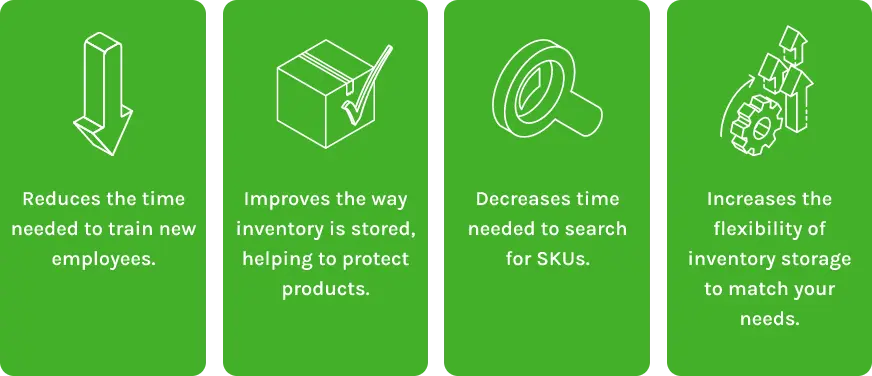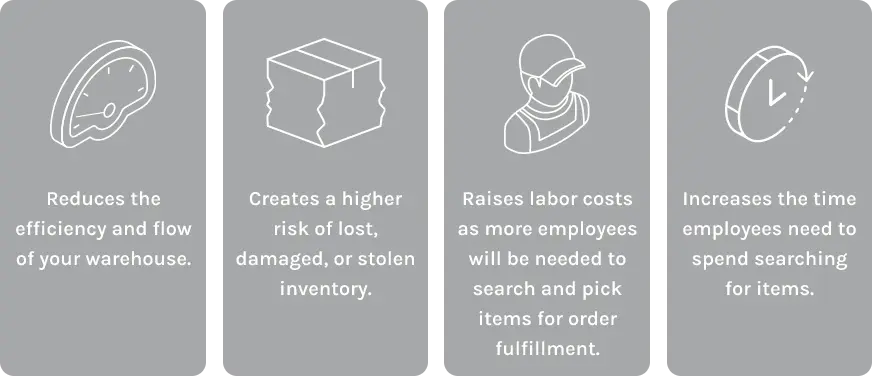60-Second Summary
This article discusses the challenges faced by businesses due to labor and supply chain issues since the pandemic began, emphasizing the growing need for automation in warehouse and fulfillment operations. It highlights the adoption of automated storage and retrieval systems (AS/RS) as a solution to improve efficiency, reduce costs, and address labor shortages. The text explains the advantages of dynamic over static storage and lists inventory management challenges that AS/RS can help solve, including improving warehouse space utilization and reducing inventory shrinkage and loss.
Since the beginning of the pandemic in 2020, businesses and organizations globally have been struggling with labor and supply chain challenges that have truly tested a company’s resilience to disruptions. With the global economy growing more and more volatile, concerns are increasing about uncertainty, public health, inflation, labor, and supply chains.
Despite inflation, rising interest rates, and low consumer confidence, consumers have continued to buy from retail brick-and-mortar stores and online while making sacrifices to other purchases they may need while companies continue to struggle with these challenges. Nearly three in four employers (73%) are having difficulty attracting the employees they needed in 2022 for consumer-based businesses, a 3X increase from the previous year.
To combat this situation, organizations are implementing more creative solutions to move past labor and supply chain challenges, like implementing dynamic automation solutions in warehouses and fulfillment operations.
Incorporating Automation into the Inventory Management and Fulfillment Process
As companies need to keep up with sharply fluctuating consumer demand, many organizations have begun rapidly adopting automation in their operations. According to Research and Markets, the global warehouse automation market is expected to reach USD $33.34 billion from 2022-2026 at a CAGR of 13.60%.
Implementing a dense automated storage and retrieval system (AS/RS) in your warehouse, distribution center, or micro-fulfillment center has significant potential to increase efficiency, reduce costs, save floor space, and streamline inventory management without needing more labor. Learn more about AS/RS systems and the full benefits they provide, plus other types of automation, in our Ultimate Guide to Warehouse Automation blog.
Static vs. Dynamic Storage: Which is Right for You?
Understanding the two main types of storage solutions and the benefits of each is the first key to solving labor and fulfillment challenges.
What is Static Storage?
You’re likely more familiar with static storage, which is inventory stored in fixed locations that rarely change, such as shelving or racking. This type of storage can be easier for employees to learn, but it has many drawbacks:

What is Dynamic Storage?
Dynamic storage solutions are commonly designed to be modular and flexible to optimize the way inventory moves throughout your warehouse, significantly saving you time and money. Some examples of dynamic storage are movable racking, conveyor systems, and a dense storage AS/RS system.
Depending on the type of dynamic storage solution, the cost to implement can be higher than static storage, but provides many benefits such as:

With one of the leading costs of the order fulfillment process being inventory storage, implementing a form of dynamic storage throughout your distribution center will greatly help with inventory management, providing more visibility and efficiency in the fulfillment process. Dynamic storage also improves the time employees spend searching for items to pick and traveling throughout a fulfillment center. Employees even report walking as much as 10 miles a day to perform their jobs, which can be a significant source of costs.
Introducing a dynamic storage system that uses automation, such as an AS/RS, significantly reduces floor space needed for storage, provides insight to inventory status using software, and keeps inventory protected by containing it within the system.
“Employees even report walking as much as 10 miles a day to perform their jobs, which can be a significant source of costs.”
Oracle Netsuite, 2021
10 Challenges of Inventory Management
(And How Implementing an AS/RS Can Solve Them)
Inventory management poses many challenges that impact businesses. We’ve highlighted some of the key challenges relating to inventory management and how implementing an AS/RS can help significantly.
1. Inconsistencies in Inventory Tracking
Manual inventory tracking or multiple methods of inventory tracking can cause redundancies and errors that inaccurately reflect inventory levels. Products can be overlooked, counted multiple times, or recorded in the wrong locations, resulting in more difficult order fulfillment and restocking processes. It’s expected that nearly 68% of supply chain managers use spreadsheets to track inventory management.
Storing inventory in a dense storage AS/RS integrated with the right software allows inventory levels and locations to be tracked at all times, helping to reduce redundancies, wasted time, and missing product.
2. Lack of Warehouse Efficiency with Manual Processes
It’s no secret that inventory management is a very manual process. Inventory management involves major components such as identifying when and how much stock to order and tracking product throughout the entire supply chain. It involves tasks including receiving, replenishment, picking, packing, and shipping.
Implementing an AS/RS helps improve efficiency and streamlines the flow of your warehouse by reducing the amount of time and manual labor needed to perform these tasks, all while allowing better insight into inventory levels and tracking.
3. Fluctuating Demand and Consumer Expectations
Consumer expectations and market demands seem to be constantly fluctuating these days, making it difficult for businesses to keep up. One day, there may not be enough inventory and the next there’s too much overflow.
Using an AS/RS to store inventory enables better insight into inventory levels, allowing for more accurate restocks. AS/RS systems also act as buffer storage and accommodate inventory overflow, keeping inventory off the warehouse floor by utilizing a warehouse’s vertical space.
4. Specialized Inventory Needs
Not all inventory is easy to store – some specialized inventory may be perishable, fragile, or require cold storage.
To accommodate these specialized types of inventory, some types of AS/RS systems, like the OPEX® Perfect Pick® AS/RS, allow for these types of goods to be specially stored or accommodate more unique inventory needs.
5. Effectively Managing Warehouse Space
Warehouse space has become a more expensive and valuable commodity, especially as real estate demand has skyrocketed in recent years with the growth of ecommerce and micro-fulfillment centers. Making the most out of your warehousing space means more effectively managing the space inventory takes up.
AS/RS systems help optimize and save warehouse space by utilizing vertical warehouse space and robotic vehicles that automatically retrieve inventory that would otherwise be more difficult for employees to reach.
6. Limited Inventory
Visibility Restocking and shipments can be delayed from not properly identifying inventory or taking too long to find the correct products. This can be very problematic, especially in warehouses with thousands of SKUs. In 2022, the average SKU count is a distribution center increased to 10,371.
AS/RS systems track inventory locations and store it securely in totes, bins, or boxes that can then be retrieved by an employee accessing the system. These types of systems also have the ability to handle thousands of SKUs without the need for more manual intervention.
7. Different Packaging Needs
Sometimes item packaging can be difficult to accommodate – more items are being produced with minimal to no packaging or compostable packaging that may leave the product vulnerable to damage.
Storing inventory in an AS/RS keeps inventory protected from damage that may otherwise be caused by mishandling or wear and tear. AS/RS systems are also flexible enough to hold different packaging types, as bins can be individually configured.
The Benefits of Implementing An AS/RS
- Increase Inventory Accuracy
- Improve Throughput with Less Labor
- Steamline Inventory Flow
- Save Warehouse Floor Space
- Reduce Labor Needs
- Increase Profitability
- Reduce Inventory Shrink and Loss
- Increase Productivity
8. Labor Challenges
You’re likely very familiar with this problem. From not having enough staff, needing too many people to handle manual processes, or not having the right expertise involved in warehouse tasks, it can be challenging to keep productivity up.
AS/RS systems reduce the need for labor in repetitive, inventory-related tasks while increasing productivity and streamlining inventory flow. Labor typically accounts for 65% of the fulfillment process. With wages expected to climb for companies in order to remain competitive and keep up with inflation, automation will play a huge factor in effective inventory management while keeping costs low.
9. Inventory Shrink and Loss
Inventory shrink and loss can be a significant expense for warehouses, resulting from damaged, lost, miscounted, or stolen inventory.
Inventory can be securely stored using an AS/RS, protecting product from damage, mishandling, or unauthorized use.
10. Limiting or Inadequate Software
To effectively manage inventory with software, it must integrate with other supply chain and order fulfillment software used in the process. Some software may still require time-consuming and labor-intensive manual data entry that slows down the fulfillment or replenishment process.
Typically, AS/RS systems can integrate with a wide range of inventory management software and already have some degree of inventory tracking ability. Utilizing both software and automation can be an effective solution that streamlines inventory management while reducing labor and space costs.
Are You Ready to Optimize Your Inventory Storage?
OPEX Warehouse Automation solutions deliver game-changing technology that transforms the way businesses manage inventory, fulfill orders for ecommerce, and handle returns processing. As a vertically integrated company that provides our customers with our specialized warehouse automation systems and our own dedicated service, we have the experience and tools you need to transform your operations.
Looking for More Information?
Read our white paper, Scalable Storage and Retrieval to Match Warehouse Progressive Demands, to learn more about how warehouses operating in today’s business environment respond to fluctuating demand, both now and in the future.
Other Resources You Might Find Helpful
Case Study
How Ingram Micro Increased Throughput in a Small Footprint
15 min read
White Paper
Scalable Storage and Retrieval to Match Warehouse Progressive Demands
15 min read
Insight
Optimizing Inventory Storage with a Dense ASRS
15 min read
Last Item
Last item text for final slider item on this page
15 min read
NEXT LEVEL AUTOMATION
Unlock Operational Efficiency with OPEX
OPEX is powering the future of automation. Contact us to learn more about how our vertically integrated automated solutions can help take your business to new heights.